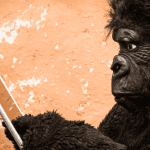 Creepy
Creepy  Creepy
Creepy  Technology
Technology 10 Scientific Breakthroughs of 2025 That’ll Change Everything
 Our World
Our World 10 Ways Icelandic Culture Makes Other Countries Look Boring
 Misconceptions
Misconceptions 10 Common Misconceptions About the Victorian Era
 Mysteries
Mysteries 10 Strange Unexplained Mysteries of 2025
 Miscellaneous
Miscellaneous 10 of History’s Most Bell-Ringing Finishing Moves
 History
History 10 Great Escapes That Ended Right Back in Captivity
 Weird Stuff
Weird Stuff 10 Fascinating Things You Might Not Know About Spiders
 Food
Food 10 Everyday Foods You Didn’t Know Were Invented by the U.S. Military
 History
History 10 Odd Things Colonial Americans Kept at Home
 Creepy
Creepy 10 More Representations of Death from Myth, Legend, and Folktale
 Technology
Technology 10 Scientific Breakthroughs of 2025 That’ll Change Everything
 Our World
Our World 10 Ways Icelandic Culture Makes Other Countries Look Boring
Who's Behind Listverse?

Jamie Frater
Head Editor
Jamie founded Listverse due to an insatiable desire to share fascinating, obscure, and bizarre facts. He has been a guest speaker on numerous national radio and television stations and is a five time published author.
More About Us Misconceptions
Misconceptions 10 Common Misconceptions About the Victorian Era
 Mysteries
Mysteries 10 Strange Unexplained Mysteries of 2025
 Miscellaneous
Miscellaneous 10 of History’s Most Bell-Ringing Finishing Moves
 History
History 10 Great Escapes That Ended Right Back in Captivity
 Weird Stuff
Weird Stuff 10 Fascinating Things You Might Not Know About Spiders
 Food
Food 10 Everyday Foods You Didn’t Know Were Invented by the U.S. Military
 History
History 10 Odd Things Colonial Americans Kept at Home
10 Surprisingly Dark Moments in Seemingly Benign Books
Let’s flip the script on one of our old lists. Imagine cracking open a book for some mild escapism. Experience a fun, colorful, harmless fantasy world. Look behind the scenes for the life of an innocuous celebrity. Now, put a scene that would be considered envelope-pushing if Stephen King or Grady Hendrix included it in one of their books. Scenes of violence, moral nihilism, or the eerily uncanny. Adding to the impact of horrific scenes into stories where the reader doesn’t have their guard up can mean that one scene has more impact than entire successful novels written and advertised as horror, fiction, or otherwise.
Related: 10 Comic Books Deemed Too Hot to Handle
10 Darrell Hammond’s Autobiography
For younger readers, Darrell Hammond was a longtime cast member for the American cultural institution Saturday Night Live. He performed more than 107 celebrity impersonations from 1995 to 2009 before he left the regular cast and took on the role of the announcer. His most prominent role was probably President William Jefferson Clinton (which he claimed was JFK with a Southern accent). His second most notable was playing an antagonistic Sean Connery in a recurring version of Celebrity Jeopardy. In the process, he did not really gain any reputation for drug addiction, abusive behavior, etc.
Still, he came clean in 2011 with his autobiography God, If You’re Not Up There, I’m F*cked. As reviewed by AV Club in 2016, he shares very little of note about his time as a cast member on one of the longest-running, most famous shows on television. What he does relate in vivid, stomach-churning detail is the childhood abuses he suffered at the hands of his parents, particularly his mother. Consider this haunting passage:
“I am 3 or 4 years old, and my mother is holding me close to her with one arm. In her free hand, she holds a serrated steak knife. Slowly, she sticks it into the center of my tongue, making an incision about one-quarter inch to one-half inch long. It is quiet except for the sound of the hibiscus bush thump-thumping against the kitchen window. I do not struggle or cry. Somehow, I know that to do so will make it worse.”
Unsurprisingly, this was a memory that Hammond repressed for a long time to function in daily life. For many, it’s a mental image they won’t be able to watch him in one of his old episodes of SNL or in movies such as Scary Movie 3 without remembering.[1]
9 Animorphs
Between 1996 and 2001, this series was inescapable at elementary school book fairs and ran for fifty-four books. Its covers, featuring the use of digital face-altering before the technology was ready for it, give the impression the books are harmless ’90s kitsch, and the spinoff TV series certainly didn’t help. The content of the story, where children use the ability to disguise themselves as animals to thwart an alien invasion, had much more on its mind. For example, Applegate deliberately eschewed any sort of Harry Potter-like happy ending in favor of an ambiguous one to prevent any war-glorifying impression being left by the book series.
On a more visceral level, Applegate was willing to take the novels to places where David Cronenberg seemed like he would be the most appropriate director to adapt the series. One of the most memorable instances is in the 1997 novel The Andalite Chronicles (the Andalites being an alien race that sides with humanity, and provides the kid protagonists with the ability to animorph), the protagonist Loren enters an alternate dimension, which features a McDonald’s modeled on one from her memories. It’s a replica down to an employee with an acne problem that she found off-putting. So off-putting, in fact, that the copy of him based on her memories doesn’t have a face, just a gigantic throbbing zit. Yet it still functions like a regular fast-food restaurant employee. It’s an impeccable synthesis of nightmarish uncanniness and childish revulsion.[2]
8 The Fairy Rebel
This 1985 book from Lynne Reid Banks was definitely less prominent in its time than her 1980 hit kids’ novel The Indian in the Cupboard. (Kirkus Reviews, for one, called it “lighter weight” than its more famous companion.) Still, this story of the human couple Jan and Charlie having a child, Bindi, through the forbidden magical intervention of Tiki the fairy was assigned reading at many elementary schools for years afterward, in no small part due to a glowing review from the School Library Journal. That meant at least hundreds of thousands of children were required by the U.S. Department of Education to experience the following scene.
In the second half of the book, Bindi, at age eight, is given a cursed item by the tyrannical fairy queen to initiate her revenge. Because wasps are a particularly feared cause of death for fairies in the world of this book, part of the curse is the manifestation of wasps. Bindi is particularly surprised to see a wasp emerge from a sealed box of cereal. Even that pales in contrast with when a wasp appears in the bathroom… by leaving the toothpaste tube. As Banks understates it, Bindi went to school with “teeth unbrushed.”[3]
7 Dirty Jokes and Beer: Stories of the Unrefined
The Drew Carey Show was two years into its ultimately nine-year run when Drew Carey published his autobiography in 1997. The general premise of the show is following the experience of a blue-collar worker kicked up into a white-collar environment as an assistant director of personnel. It’s a minor time capsule in how shocking Carey expects it to be that he uses profanity in the jokes that preface most of the chapters. Such content nowadays would be considered banal for an Amazon Prime program.
What’s more likely to take the reader aback is Drew Carey’s admission that he had been molested as a child… by a family member. The passage is not graphic and is generally free of comedy, with Carey recommending that other victims not repress such experiences. The only attempt at levity in the scene is when Carey jokes that he can imagine that this admission on his part is sure to make the book a bestseller. It leaves a lingering impression that if someone as affable and salt of the earth as Drew Carey has such an experience in his background, who else does and has managed to hide it behind a veil of normalcy?[4]
6 Little Miss Trouble
Begun in 1971, former advertising agent Roger Hergreaves’s Mr. Men book series sold more than 100 million copies and made him the third bestselling author in British history. The series was simplicity embodied, with the characters mostly having single shapes and personality traits (Mr. Happy, Mr. Grumpy, etc). Colorful with broad lines, as seen in such entries as this 1981 book, the stories could go to conceptually dark places.
In Little Miss Trouble, the titular character lies to both Mr. Clever and Mr. Uppity that Mr. Small insulted them behind their backs. In response, they both go and punch Mr. Small, giving him two black eyes. When Mr. Small confronts her about it, she laughs in his face.
It’s not graphic body horror, but there’s something dangerous under the surface of the Mr. Men World if all it takes is two relatively slight insults delivered second-hand to drive the denizens of this world to escalate situations to physical violence. Surprisingly, the problem isn’t resolved through Mr. Clever or Mr. Uppity making amends, but by Mr. Small lying about something Little Miss Trouble said.
Storytelling like this in popular canonical kids’ literature renders horrific deconstructions such as Don’t Hug Me, I’m Scared practically redundant. Unsurprisingly, this was all changed for the 1981 cartoon adaptation so that Mr. Small accidentally hurts himself instead of getting punched twice.[5]
5 Love You Forever
A book does not become the fourth-largest-selling paperback children’s book of all time without resonating with an audience. Author Robert Munsch’s motivation for writing it certainly came from an honest place: The refrain at the heart of the book is a mantra he would recite in his head to cope with his wife’s two miscarriages. Yet there is a scene (some would argue a pair of scenes) that has caused this book to be hit by considerable backlash over the years, and many to dub the experience overall creepy and unhealthy.
In Love You Forever within the story is a four-line poem that a mother recites to her child from infancy. The scenes of her rocking the child to sleep in her arms represent the height of maternal affection. In the end, she attempts to recite the poem to her son one last time on her deathbed and doesn’t have the energy to finish it. So the son carries on the tradition with his own child.
What many readers found uncomfortable were the scenes where the mother continues this practice when her son is no longer a child. By his teenage years, when most offspring begin to become their own people and often start rebelling against their parents, the idea of still being rocked by a parent while asleep is more uncomfortable than anything else. If not that period, then the scenes where, after her son has moved out, she climbs a ladder to enter his bedroom and still rocks him in his sleep are at least stalkerish behavior. This would likely have gone over better in a more whimsical book, but Love You Forever’s art and story are so grounded in reality that many readers couldn’t suspend their disbelief for it, as kids or adults.[6]
4 A Bad Case of the Stripes
David Shannon’s 1998 book certainly acquired a high profile in its time. For example, a single video of Sean Astin reading it has over 12 million views, and that’s not the most popular one. Schools have adapted it for both stage and screen, though it has not had a commercial film adaptation (yet.) On the other hand, multiple popular videos call it, among other things, “body horror for children” or even ask, “Why is this a book?” This is not any sort of fringe, online opinion. A Publisher’s Weekly review called the book overall “disturbing” and the imagery “grotesque.” How do we account for these polarized opinions?
The story is essentially that because a kid named Camilla Cream stops eating lima beans to conform to the societal expectation that kids don’t like lima beans. One morning, her skin changes to be striped, then goes through a variety of other patterns. The affliction moves on to having her manifest branches, a cat tail, tentacle-like growths, viruses, etc. The descriptor “Lovecraftian” might be overused, but it applies to the results of Camilla’s Animorphs-esque ordeal. Camilla is cured by being fed the lima beans, embracing her true self over conformity. However, that lesson is very likely to be overshadowed in children’s memories by the image of Camilla Cream as a polymorphic mutant balefully watching television.[7]
3 Pinocchio
By now, many people online know how the 1940 Disney adaptation of Carlo Lorenzini’s 1883 work bowdlerized the original novel to be more tame, such as a scene where Pinocchio is unsuccessfully lynched. Even so, Disney’s portrayal of characters such as Stromboli and the Coachman who takes children to Pleasure Island was considered surprisingly scary. Yet, a single scene of the Coachman from the original book completely overshadows the supposed horrors of the cartoon.
“The little fat man did not laugh. He went up to the rebellious animal and, still smiling, bent over him lovingly and bit off half of his right ear.”
That’s not so much something you’d expect from a fun villain fit to be included in elementary school plays as an act characteristic of Judge Holden from Blood Meridian. Notably, even “dark” reimaginings of Pinocchio, such as Robert Benigni’s or the 1994 horror film riff on Pinocchio, don’t have anything so casually grim.[8]
2 Oh, the Thinks You Can Think!
Oh, the Places You’ll Go! overshadows it considerably, but Oh, the Thinks You Can Think predates its similarly tilted and themed counterpart by fifteen years, published in 1975 versus 1990. Oh, the Thinks You Can Think is largely a string of silly tableaus, such as asking the reader if they’ll dare to pull a tooth from a stone statue called a “rink rinker-fink.”
Most notable are pages 30 and 31. There, the main character is on a narrow, lonely street and is rendered as a boy in the distance to emphasize his smallness. In the foreground is a roughly sketched, tall, lanky bird-headed creature. The text reads, “And what would you do if you meet a Jibboo?” The composition, combined with the ominous tone, gives an impression of danger, even though the Jibboo is waving.
The scene became notoriously unsettling for readers, such that the 2018 book Doctor Seuss and Philosophy by Jacob Held referred to the Jibboo as a “scary creature.” Seuss, for his part, seems to have responded to the feedback by giving the Jibboo character a cameo in 1977 in the cartoon he directed, Halloween is Grinch Night. The second time, the Jibboo wasn’t offering a wave or anything so superficially reassuring.[9]
1 Garfield: His Nine Lives
It’s beyond trite by this point to use Garfield’s comic strip and merchandise empire as a punching bag for comedy that’s supposedly lost all its edge and vitality due to formula and overly safe jokes. What’s surprising then about the “Primal Self” comic from this 1984 Garfield anthology was that Garfield was only six years old at the time. It was hardly old and ubiquitous enough for it to become the popular consensus that Garfield had lost its edge before this extremely non-formulaic short story was published.
“Primal Self” barely qualifies as a story. A cute tabby cat named Tigger wakes up, drinks from a bowl, and studies a crude black painting of a cat someone painted next to an electrical outlet. At first, whenever Tigger looks away, green and black energy is emitted from the object the cat has just interacted with until black and green energy emerges from the wall. Tigger initially hisses, then the energy forms into a cat. The energy cat touches Tigger, who is given a shock of energy, which implies that Tigger should be put back in touch with the spirit of ancient sabretooth ancestors. In the end, Tigger is called over and attacks their owner, the final image being an unsuspecting grandmotherly type looking around as Tigger is mid-air, fangs and claws bared.
Whether this was Jim Davis, who indeed wrote the script for artists Jim Clemenrs, Gary Barker, and Larry Fentz to illustrate, working out some feelings of constraint he got from the comic, an experiment, or something else entirely is unclear. What is known is that “Primal Self” was not included in later editions of the book and was not included in the animated adaptation. Squeamishness with the completed story of rights issues over naming the cat in the story Tigger are equally plausible explanations for this.[10]








